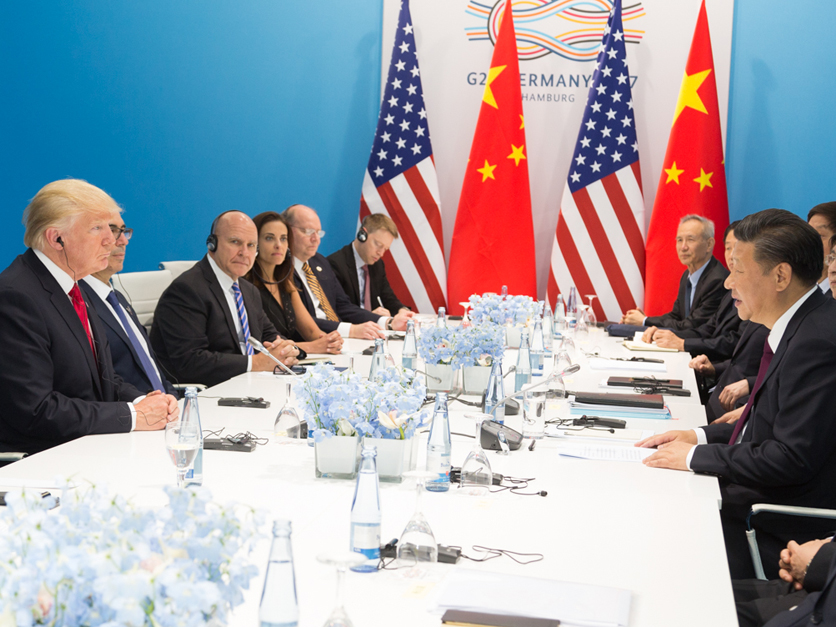President Donald Trump says he’s still confident the U.S. and China can reach a deal to end the trade war, but talks have all but collapsed, both sides are threatening even more or steeper tariffs and the U.S. is scrambling to protect farmers with more aid.
Much may hinge on a scheduled meeting between Trump and Chinese President Xi Jinping when the two leaders attend a G-20 summit in Osaka, Japan, in late June. No new negotiating rounds have yet been scheduled before Trump and Xi are scheduled to meet.
“I think it's going to turn out extremely well,” Trump said Tuesday about the talks in general with China. “We're at a very strong position.”
But it doesn’t feel that way for many in the U.S. ag sector, especially the farmers and ranchers who have been hit the hardest by China’s retaliatory tariffs.
“The U.S. has been at the table with China eleven times now and still has not closed the deal,” says American Soybean Association President Davie Stephens. “What that means for soybean growers is that we’re losing. Losing a valuable market, losing stable pricing, losing an opportunity to support our families and our communities. These trade negotiations are serious for us. Farming is our livelihood.”

Davie Stephens, ASA
U.S. soybean exports to China virtually halted last year after the Chinese hit them with a 25 percent tariff, just part of the country’s retaliation that also drastically curtailed U.S. shipments of sorghum, pork, oranges, apples and almonds, just to name a few.
The U.S. exported $3.1 billion worth of soybeans to Chinese importers in the 2018 calendar year, about a quarter of the $12.3 billion it sold to them in 2017, according to USDA data.
American Farm Bureau Federation President Zippy Duvall on Tuesday made a plea directly to Trump to end the trade war with China. Farmers, Duvall said, are frustrated and some are just giving up.
“I am hearing anecdotal reports of farmers, particularly those who are dealing with planting delays due to weather, deciding not to plant a crop this year because there’s just no market for it,” Duvall said in a letter to Trump dated May 14, a copy of which was obtained by Agri-Pulse. “We ask that your trade negotiators make a deal as soon as possible to end the tariffs that are slashing our exports, destroying a once-promising market for agriculture, worsening the farm economy, and contributing to high levels of stress and uncertainty for many farm and ranch families and other Americans whose jobs are connected to agricultural production.”
California farmers saw their orange exports to China drop by 75 percent this year because of import taxes as high as 51 percent, Joel Nelsen, strategic adviser and past president of California Citrus Mutual, told Agri-Pulse.
Trump continues to say that China is desperate for a deal to end the trade war — and he’s still confident he has the upper hand — but the two countries are further apart than they have been since December when a Trump-Xi meeting in Argentina appeared to revitalize talks.
“But we had a deal that was very close, and then they broke it,” Trump said Tuesday. “They really did. I mean ... more than renegotiate, they really broke it. So we can't have that happen.”
U.S. Trade Representative Robert Lighthizer announced the breakdown in talks on May 6, just after he and Treasury Secretary Steven Mnuchin returned from trade negotiations in Beijing. China, he said, had reneged on several major promises. That same day, he announced the U.S. would increase the tariff rate on $200 billion worth of Chinese goods. Soon after, China responded by announcing it would raise the tariff rates on $60 billion of U.S. products.
It could get worse.
Trump has threatened to hit China with a 25 tariff on another $300 billion worth of its products. That, together with the existing tariffs on about $250 billion of goods, would cover all of what the U.S. imports from the Chinese.
China has threatened to retaliate again.
Lighthizer didn’t go into detail about China’s broken promises, but USDA Trade Undersecretary Ted McKinney told reporters Tuesday that ag policy was impacted by China’s alleged backsliding on agreements.
“The discussions on ag had gone well,” McKinney explained. “We were pleased, but … we were on a digital video conference (with the Chinese) and I looked at (USTR Chief Agricultural Negotiator Gregg) Doud and he looked at me and we said, 'this is different,' and we sensed the backsliding starting … There was distinctly a change of views by (the Chinese negotiators).”
Beyond the requests for China to simply make massive purchases of U.S. farm commodities, the U.S. has also been pressing the country to change policies that restrict U.S. exports. U.S. negotiators have asked China to remove bans on ractopamine and growth hormones, overhaul its biotech approval system, enact grain quotas and end domestic price subsidies.

USDA Trade Undersecretary Ted McKinney
But all of that is in doubt, and farmers are increasingly expressing frustration.
“We’ve been understanding during this negotiation process, but we cannot withstand another year in which our most important foreign market continues to slip away and soybean prices are 20 to 25 percent, or even more, below pre-tariff levels,” said ASA Chairman John Heisdorffer. “The sentiment out in farm country is getting grimmer by the day. Our patience is waning, our finances are suffering, and the stress from months of living with the consequences of these tariffs is mounting.”
That sense of frustration from America’s heartland is loud and clear to the White House. It’s also a major reason the Trump administration is pressing USDA to quickly put together a massive new assistance package for farmers and ranchers.
The message to farmers, McKinney said Tuesday, is “we’ve got your back.”
“In truth, do we want that?” McKinney said about more assistance after the first $12 billion package that was unveiled last year. “Do farmers and ranchers want that? No. None of us want it, but we’re grateful that it’s there as a way of saying, ‘Until we straighten out some of these … unfair trading practices, we’re at least going to give our farmers and ranchers a backstop.”
Farmers are hurting even with government aid, Duvall said in his letter to Trump.
“In 2018, U.S. agricultural exports to China declined $10 billion — about a 50 percent loss,” Duvall wrote. “This is a drastic reversal for what had been a growing market.”
But Doug Schroeder, a soybean farmer and Vice Chairman of the Illinois Soybean Association, just wants the trade war to end.
“That’s no long-term way to run a business, Schroeder told Agri-Pulse. “We want to thrive as an industry and … We need the ability to do what we do: Put beans in the ground and grow that competitive crop the world needs … We don’t want the bailout.”
USDA hopes the timing of the assistance package — something McKinney said could be released in “days, not weeks” — will not change the minds of local farmers or global grain buyers. Despite Trump’s tweets and their heavy emphasis on global food aid, McKinney said “we do not want to do anything that would hurt possible, potential commercial sales."
Bill Northey, the undersecretary charged with leading USDA’s farm programs, said one of USDA’s principles in developing the package is “not to influence planting decisions for producers.” That may be a tough goal to achieve given the timing of announcement; producers across the country are battling wet conditions that are delaying their fieldwork, so any program announced in the next few weeks may well hit the news before planters hit the storage sheds.
“Plant for the market, don’t plant for a package that’s yet to be decided what it is; Don’t try and guess what it’s going to be,” Northey cautioned. “I don’t know exactly what it's going to end up being.”
According to USDA’s weekly Crop Progress Report, only 30 percent of the nation’s corn crop is in the ground (less than half of the 66 percent five-year average) and a mere 9 percent of soybeans are planted (about a third of the 29 percent five-year average).
For more news, go to www.Agri-Pulse.com.


